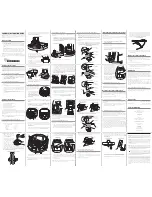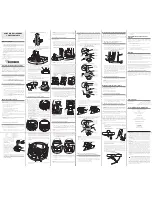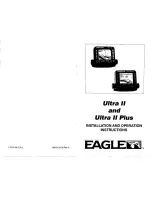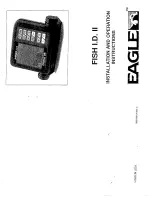
8. Snap the support plate onto the rear of the connector holder (see the
illustration
Snapping on the Support Plate
).
9. Insert the connector holder into place and fasten it to the mounting bracket
using the two #6-32 x 3/4" screws (see the illustration
Assembling the
Connector Holder
).
Hand-tighten only.
2.
Routing the Cables in the Base
In this procedure, you will route the power and
transducer jumper cables on the underside of
the base, and attach the tie-down straps that
will be used to secure the battery to the base in
a later procedure.
1. Turn the base upside down, then thread
the two included hook and loop battery
tie-down straps from the bottom of the
base up through each side of the
battery well, using the strap holes (see
the illustration
Attaching the Battery
Tie-Down Straps
).
Support
Plate
Snapping on the Support Plate
Assembling the Connector Holder
Thank you for purchasing a fishfinder from Humminbird®, America’s #1
manufacturer of quality consumer marine electronics.
BEFORE YOU BEGIN
The Portable Fishing System is available in two different configurations:
• the
Portable Control Head
, which includes a control head with portable
case and power cable, a transducer jumper cable, a transducer and a
portable mounting bracket, battery, battery charger, and connecting
hardware.
• a
Portable Conversion Kit
, which will allow you to convert a fishfinder you
may already own into a portable unit. This includes a portable case for the
control head, a power cable, a transducer jumper cable, a portable
mounting bracket, a battery, battery charger, and connecting hardware.
NOTE:
Some international models may not include a battery or battery charger.
There may be some minor differences between the hardware described in this
manual and the actual hardware included, depending on the configuration you
purchased.
PORTABLE CASE ASSEMBLY
You should perform the portable case assembly tasks in order, referring to the
step-by-step procedures that represent the following main assembly tasks:
• Assembling the quick disconnect mount
• Routing the cables in the base
• Assembling the portable case
• Attaching the control head to the portable case
• Charging and installing the battery
• Assembling the transducer mounting bracket
• Stowing the portable transducer and battery charger into the portable case.
When you are done, the control head and the transducer will be part of the
portable case assembly, and you will be ready to take your portable case to the
boat for final setup.
NOTE:
If you are converting a fixed mounting to portable using the Portable Conversion
Kit, first go to the
Portable Conversion Kit
section.
1.
Assembling the Quick Disconnect Mount
In this procedure, you will install the quick disconnect mount to the base of the
portable case, and then install the cable collector onto the quick disconnect mount.
1. Determine which set of quick disconnect mounting holes to use by
referring to the following table.
300 Series™ ............................ Hole Set A
500 Series™ ............................ Hole Set B
Matrix® .................................... Hole Set B
700 Series™ ............................ Hole Set B
PiranhaMAX™ Series .............. Hole Set C
2. Turn over the base, and use a
screwdriver or an awl, plus a
hammer to punch out the selected
mounting holes as shown in the
illustration
Punching Holes
.
3. Line up the quick disconnect mount
on the portable base, using the holes
you punched out in step 2 on the
base.
Make
sure
the
quick
disconnect mount is fully raised
(ratcheted
open),
with
the
Humminbird® logo facing towards
the battery well on the base.
4. Using a socket wrench and a Phillips screwdriver, secure the quick
disconnect mount to the base with the four included 1” screws, lock
washers, and nuts (see the illustration
Attaching the Quick Disconnect
Mount to the Base
.)
Hand tighten only!
Attaching the Quick Disconnect Mount to the Base
2. Pull the power cable through the opening in the long side of the cable well and
insert it into the battery well (see the illustration
Installing the Cables Onto
the Base
).
3. Route the transducer jumper cable (see the illustration
Installing the Cables
Onto the Base
) out the short side of the cable well and follow the arrows on the
base (see the illustration
Cable Path Under the Base
).
4. Fit the transducer jumper cable connector down into the jumper cable well
and snap it into place. Insert the two #6-32 x 1/4" screws included to secure
the transducer jumper connector and tighten using a Phillips screwdriver.
Hand tighten only!
5. Secure all cables to the base, using the included zip ties, at the mount points
shown in the illustration (see the illustration
Tying Down the Cables
).
Cable Path Under the Base
Installing the Cables Onto the Base
Transducer
Jumper
Cable
Screws
Power Cable
Jumper Cable Well
5. Route the power cable, and then the transducer jumper cable, from under
the base and up through the quick disconnect mount (see the illustration
Pulling the Cables Through the Base
).
6. Insert both the power and the transducer
jumper cable plugs into the connector holder.
The cable plugs are labeled, and there are
corresponding labels on the connector holder.
The slots for the plugs are keyed to prevent
reverse installation, and insertion should be
easy - do not force plugs.
7. Carefully pull the excess cable from beneath
the mounting surface so that the connector
holder aligns with the mounting holes on the
front of the mounting bracket.
Pulling the Cables Through the Base
6. Turn the base right side up and pull up gently on the battery tie-down straps
to remove the slack.
NOTE:
You will need to perform more assembly procedures, as well as charge the battery
for 8 hours, before you install the battery into the portable case. See
5. Charging and
Installing the Batter
y for more information.
Tying Down the Cables
Zip Tie
Mounting
Point
Transducer
Jumper Cable
Power
Cable
3.
Assembling the Portable Case
In this procedure, you will install the handle onto the base, and install the base into
the portable case.
1. Install the handle onto the base, so that the curved part of the handle faces
towards the back of the base, towards the battery well. Use the four
included #8-32 x 7/16" screws, two on each side, to attach the handle to the
base (see the illustrations
Installing the Handle Onto the Base
and
Sliding
in the Handle
).
Hand tighten only!
NOTE:
The handle is keyed so that it only fits onto the base in one way.
Sliding in the Handle
Installing the Handle Onto the Base
NOTE:
To remove the control head, grasp it with both hands, then firmly press the latch on
the rear of the control head and lift. The latch on the Quick Disconnect Mount is heavy-
duty to withstand marine use, and significant force must be applied (see the illustration
Removing the Control Head
).
5.
Charging and Installing the Battery
In this procedure you will charge and then install and secure the battery.
1. Charge the battery, using the included battery charger, until it is fully
charged as indicated by the LED on the charger. Charging usually requires 8
continuous hours, but may vary depending on your configuration.
NOTE:
Some international models may not include a battery or battery charger.
Installing the Control Head
Firmly Press
Latch to
Remove Unit
Removing the Control Head
2. Install the base and handle assembly into the portable case by unzipping the
largest opening in the portable case (on the front) and inserting the base
into the portable case, so that the Quick Disconnect Mount is towards the
front of the portable case. Pull the bag over one shoulder of the handle at a
time for best results. Make sure that you can grab the handle through the
fabric handhold inset from the outside top of the portable case (see the
illustrations
Installing the Base into the Case
,
Pulling the Case over the
Handle
, and
Holding the Portable Case
).
4.
Attaching the Control Head to the Portable Case
In this procedure, you will install the control head into the portable case, using the
quick disconnect mount.
1. Make sure the front (large) opening in the front of the portable case is
unzipped; you may want to roll up the flap and secure it with the provided
strap and clip while you’re working.
2. Slide the control head onto the quick disconnect mounting bracket until it is
fully seated (see the illustration
Installing the Control Head
).
Installing the Base into the Case
Pulling the Case over the Handle
Holding the Portable Case
2. Open the bottom back zipper on the portable case, and install the battery in
the battery well. While holding the tie-down straps out of the way, make
sure the power cable is fitted snugly into the slot in the well so that the
battery does not rest on it (see the illustration
Installing the Battery
).
3. Pull the two battery tie-down straps over the top of the battery and
connect both ends of each strap over the top, making sure that the straps
are pulled tight around the battery and that the battery is seated securely
in the battery well.
4. Zip up the back opening.
NOTE:
Do NOT connect the power cable to the battery at this time. You should wait until
just before fishing to connect the power cable to the battery.
Installing the Battery
Tying Down the Battery
6.
Assembling the Transducer Mounting Bracket
NOTE:
Please be aware that the transducer design has changed. If you are replacing or
adding mounting hardware to your current transducer, make sure that you have selected
the appropriate hardware. If you are replacing a transducer, you will need to replace the
mounting bracket and hardware as well. Contact our Customer Resource Center at either
1-800-633-1468
or visit our website at
www.humminbird.com
for more information.
In this procedure you will determine which mounting bracket you have and assemble
your transducer.
1a. If your transducer mounting bracket looks like one of the following illustrations,
assemble it as shown.
Hand tighten only!
Then skip to procedure
7. Stowing
the Portable Transducer and Battery Charger into the Portable Case
.
or...
Portable Transducer
Assembly
Phillips Head
Screw
Lock Washer
Suction
Cup
Wing Nut
Screw
Assembling the Metal Bracket
Assembling the Plastic Bracket
Phillips Head
Screw
Lock Washer
Wing Nut
Washer
Phillips
Head Screw
Suction Cup
Portable Transducer
Assembly
Assembling the Plastic Bracket
Suction Cup
Portable Transducer
Assembly
Lock Washer
Wing Nut
Washer
Phillips Head
Screw
Phillips Head
Screw
1b. If your transducer mounting bracket looks like the one below, line up the two
ratchet pieces at position 1 so that the beads are aligned with the rib on the
transducer. See illustrations.
2. Assemble the other transducer parts as shown (see the illustration
Assembling the Plastic Bracket
below).
Hand tighten only!
Assembling the Plastic Bracket
Suction Cup
Portable Transducer
Assembly
Phillips Head
Screw
Bolt
Ratchet
Wing Nut
Washer
Transducer Knuckle Positions
Ratchets Placed in Position 1
Rib at
position 1
Knuckle
Beads
Ratchet
NOTE:
If you are unable to ratchet the transducer so that is rests below the water and
points straight down, you can disassemble it and align the beads with a different number
until you reach a position that allows the proper alignment.
7.
Stowing the Portable Transducer and
Battery Charger into the Portable Case
1. Load the portable transducer into the carrying compartment (upper zip
opening on the back of the portable case) and close the zipper.
2. Turn the portable case around so that you can access the front, and load the
battery charger into the zip pocket on the left as you face the front of the
portable case.
3. Make sure all the zippers are closed.
Ratchets Placed in Position 2
Bead
Ratchet
Rib
INSTALLING THE PORTABLE CASE ON THE BOAT
Since the portable case has a large non-skid mounting surface, it may be attached
to almost any surface.
In this section, you will route the cables on the boat, connect the transducer and
power cables to the portable case, and attach the portable case to a dry and
convenient location on your boat.
1.
Connecting the Transducer and Power Cables
to the Portable Case
1. Make sure the large opening in the front of the portable case is unzipped;
you may want to roll up the flap and secure it with the provided strap and
clip while you’re working.
2. Plug the transducer cable into the jumper port in the portable case to the left
of the control head, as you face the front of the bag (see the illustration
Plugging in the Transducer
).
Plugging in the Transducer
3. Turn the portable case around so that
you can access the back, and open the
back zipper. Connect the spade clip on
the red wire of the power cable to the
red terminal on the battery, and the
spade clip on the black wire of the
power cable to the black terminal on
the battery, and make sure that the
spade clips are snugly attached to
the terminals (see the illustration
Connecting the Spade Clips
).
4. Make sure the back battery door and
side pockets are zipped, but leave the
front of the bag unzipped for easy
access during installation.
2.
Attaching the Portable Case to the Boat
1. Attach the portable case to a surface on the boat by threading rope or bungee
cord (not provided) through the D-rings on either side of the portable case.
NOTE:
Humminbird® recommends that you do NOT position the portable case on the
bottom of the boat, or in a location where it can be splashed by or immersed in water, as
the portable case is water resistant, but not waterproof.
MOUNTING THE PORTABLE TRANSDUCER
Once your Portable fishfinder is fully assembled (see the
Portable Case Assembly
section for more information), it takes just a few easy steps before you are ready to fish:
• Test the transducer prior to installation
• Mount the portable transducer on the boat
1.
Testing the Transducer Prior to Installation
Prior to installation, test the transducer to make sure that no damage occurred
during shipping.
1. Hold the transducer in the water over the side of the boat to confirm proper
operation. If the transducer is working properly, you should be able to see
the bottom on the control head display.
2.
Mounting the Portable Transducer on the Boat
Perform the procedures in this section to install the transducer on your boat.
NOTE:
The suction cup mount is designed for quick, easy installation and removal, NOT for
high speed operation. If you intend to operate your boat at any speed faster than trolling
speeds, remove the suction cup transducer from the water.
It is important that the mounting position allows the transducer to rest beneath the
surface of the water, pointing straight down. You can mount the transducer
anywhere on the side of the boat if your boat remains stationary. If you are trolling,
it is best to mount the transducer on the transom of the boat.
Your portable transducer is designed to be installed and adjusted without the use of
tools. Mounting the transducer to the boat is a simple, yet important operation. A
poor mounting location will affect the overall performance of the Humminbird® unit,
so follow the mounting instructions carefully. It is important that the mounting
position allows the transducer to rest beneath the surface of the water, pointing
straight down. You can mount the transducer anywhere on the side of the boat if
your boat remains stationary.
If you are trolling, it is best to mount the transducer on the transom of the boat.
1. Mount the transducer so that it points straight down, and so that the
transducer itself is submerged in the water (see the illustration
Portable
Transducer Mount
).
2. Adjust the running angle so that the transducer is parallel to and below the
surface of the water (see the illustration
Transducer Running Angle
).
3. Hand-tighten the wing nut so that the transducer will not rotate.
Portable Transducer Mount
Transducer Running Angle
4. Secure the transducer cable in case of accidental release when the boat is
moving, since a loose transducer can cause damage to itself, your boat, or
become tangled in the propeller. Attach the tie-down strap to the transducer
cable around an immovable object such as a rail or fitting, as shown in the
illustration (see the illustration
Transducer Tie-Down Strap
).
5. When you have finished using the transducer, unplug the transducer
cable from the transducer jumper port on the base, then coil the cable
around the assembly.
MOVING THE PORTABLE FISHFINDER
You should take the portable case with you when you leave the boat and will not
be using it. Perform the following steps to make your unit mobile:
1. With the boat engine off, loosen all cable retainers/clips holding the
transducer.
2. Remove the case from the surface mount.
Transducer Tie-Down Strap
3. Remove the transducer from the surface where it has been mounted,
wipe it dry, and stow it in the portable case rear pocket.
4. Unplug the power cable when not in use.
MAINTENANCE
Your Humminbird® Portable fishfinder is designed to provide years of trouble-free
operation with virtually no maintenance. Follow the simple procedures below to
ensure that your Humminbird® Portable continues to deliver top performance.
If the Portable case comes into contact with salt spray, wipe the affected surfaces
with a lint-free cloth, then apply a commercially available anti-corrosive treatment
to all exposed electrical contacts.
If the portable case bag becomes dirty, clean the bag with mild soap, water, and
a soft rag or brush and then hang it up to dry.
Never leave your Humminbird® Portable unit in a closed car or trunk - the
extremely high temperatures generated in hot weather can damage the
electronics. Repairs should be performed only by authorized Humminbird®
technicians.
How to Remove Water from the Portable Case
Open the front zipper and pull the case down to allow water to exit the case. If
needed, remove the case from the plastic base and air-dry it. Follow recommended
maintenance procedures for salt spray exposure if needed.
SPECIFICATIONS
Portable Case . . . . . . . . . . . . . . . . . . . . . . . . . . . . . . 8.75" H x 10.25" W x 9.83" D
223 mm H x 261 mm W x 250 mm D
Power Requirement . . . . . . . . . . . . . . . . . . . . . . . 12 Volt sealed lead acid battery;
up to 16 hours continuous operation
CONTACT HUMMINBIRD®
Contact the Humminbird® Customer Resource Center in any of the following ways:
By Telephone:
(Monday - Friday 8:00 a.m. to 4:30 p.m.
Central Standard Time):
1-800-633-1468
By e-mail:
(typically we respond to your e-mail
within three business days):
For direct shipping,
our address is:
Humminbird
Service Department
678 Humminbird Lane
Eufaula, AL 36027 USA
PORTABLE INSTALLATION GUIDE
531571-1_C
WARNING!
This device should not be used as a navigational aid to prevent collision,
grounding, boat damage, or personal injury. When the boat is moving, water depth may
change too quickly to allow time for you to react. Always operate the boat at very slow
speeds if you suspect shallow water or submerged objects.
WARNING!
Disassembly and repair of this electronic unit should only be performed by
authorized service personnel. Any modification of the serial number or attempt to repair
the original equipment or accessories by unauthorized individuals will void the warranty.
WARNING!
This product contains chemicals known to the State of California to cause
cancer and/or reproductive harm.
WEEE Directive:
EU Directive 2002/96/EC “Waste of Electrical and Electronic Equipment
Directive (WEEE)” impacts most distributors, sellers, and manufacturers of consumer
electronics in the European Union. The WEEE Directive requires the producer of consumer
electronics to take responsibility for the management of waste from their products to
achieve environmentally responsible disposal during the product life cycle.
WEEE compliance may not be required in your location for electrical &
electronic equipment (EEE), nor may it be required for EEE designed and intended
as fixed or temporary installation in transportation vehicles such as automobiles,
aircraft, and boats. In some European Union member states, these vehicles are
considered outside of the scope of the Directive, and EEE for those applications can be
considered excluded from the WEEE Directive requirement.
This symbol (WEEE wheelie bin) on product indicates the product must not be disposed of
with other household refuse. It must be disposed of and collected for recycling and recovery
of waste EEE. Humminbird® will mark all EEE products in accordance with the WEEE
Directive. It is our goal to comply in the collection, treatment, recovery, and environmentally
sound disposal of those products; however, these requirement do vary within European
Union member states. For more information about where you should dispose of your waste
equipment for recycling and recovery and/or your European Union member state
requirements, please contact your dealer or distributor from which your product was
purchased.
Connector Holder
Transducer
Accessory
Communications
Power
PORTABLE CONVERSION KIT
If you have a Portable Conversion Kit, you must first un-install the control head and
the transducer from their respective fixed mounting positions on your boat before
performing the regular portable installation instructions described in this manual.
Once you have converted the control head and the transducer to portable
configurations, you will be ready to mount the portable case.
1.
Converting the Control Head to Portable
1. Unplug the control head from the quick disconnect mount on your boat.
2. Go to
Portable Case Assembly
and follow the instructions through
Section 5. Charging and Installing the Battery
, then come back to
Converting the Transducer to Portable
.
2.
Converting the Transducer to Portable
1. Make sure that the control head is detached from the quick disconnect
mount.
2. Pull the transducer cable out of the quick disconnect mount.
3. Unscrew the transducer from the fixed mounting bracket on your boat,
saving the original screws for any future fixed mounting configuration
(new portable mounting screws are provided in the Portable Con-
version Kit).
4. Go to
Assembling the Transducer Mounting Bracket
and follow the rest
of the procedures.
Punching Holes
Connecting the Spade Clips
Attaching the Battery Tie-Down Straps
Battery
tie-down straps
© 2008 Humminbird®, Eufaula AL, USA. All rights reserved.
41846_Install_531571-1_C:Hum_Install_531326-1_C.qxd 11/25/08 11:48 AM Page 1




